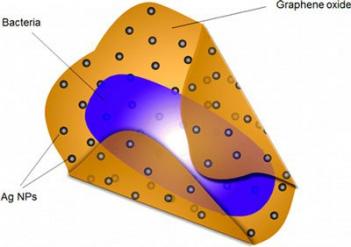Researchers from the University of Florida and Hunan Univeristy developed DNA-directed silver nanoparticles (Ag NPs) grown on graphene oxide (GO). These so called Ag@dsDNA@GO composites act as antibacterial agents, decreasing X. perforans (a model plant pathogenic bacterium) cell viability in culture and on plants.

The researchers say that this material exhibit good antibacterial activity due to the synergistic effect between the silver nanoparticles (AgNPs) and the graphene oxide (GO). In a greenhouse experiment they applied this material on tomato transplants and they reported significant reduction of disease caused by bacterial spot compared to the untreated control and the control treated with copper + mancozeb (a standard treatment). The material did not induce any phytotoxic effect on the leaves.
This research is somewhat similar to a research recently published from China's University of Science and Technology (USTC), which reported that protein-coated graphene oxide can be used to create efficient anti-bacteria agents. The GO sheets were used as a template to guide silver (or Au@Ag core-shell particles, to be exact) into a 2D array. This follows several reports regarding Graphene's potential as an anti-bacterial agent.
In June 2013 we reported that graphene can kill bacteria by slicing through their membranes and pulling out their phospholipids. Back in September 2012 it was reported that graphene-based materials kill substantially more bacteria than graphite-based materials. In February 2013 it was reported that graphene can be used for photothermal antibacterial therapy, and earlier studies demonstrated how graphene can be used as a bacteria sensor.